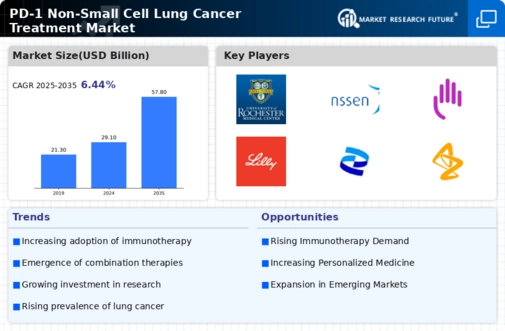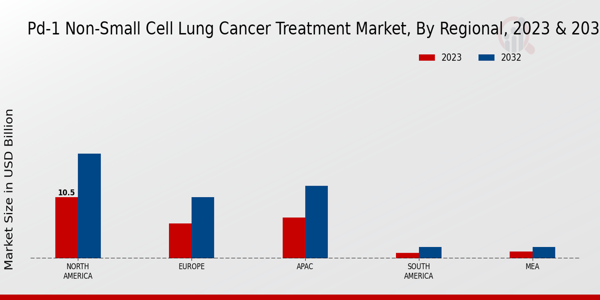Advancements in Immunotherapy
The PD-1 Non-Small Cell Lung Cancer Treatment Market is experiencing a transformative phase due to advancements in immunotherapy. PD-1 inhibitors, such as pembrolizumab and nivolumab, have revolutionized treatment paradigms by harnessing the body's immune system to combat cancer. These therapies have demonstrated improved survival rates and reduced side effects compared to traditional chemotherapy. The success of these agents in clinical settings has led to their rapid adoption, with sales figures indicating a substantial increase in revenue for manufacturers. Furthermore, ongoing research into combination therapies that pair PD-1 inhibitors with other modalities, such as chemotherapy or targeted therapies, is likely to enhance treatment efficacy. This trend suggests a robust future for the PD-1 Non-Small Cell Lung Cancer Treatment Market, as new combinations are explored and validated through clinical trials.
Growing Awareness and Education
The PD-1 Non-Small Cell Lung Cancer Treatment Market is also influenced by growing awareness and education regarding lung cancer and its treatment options. Increased efforts by healthcare organizations and advocacy groups to educate both patients and healthcare providers about the benefits of PD-1 inhibitors are fostering a more informed patient population. This heightened awareness is likely to lead to earlier diagnosis and treatment initiation, which can significantly improve patient outcomes. Additionally, educational campaigns are encouraging discussions about personalized medicine and biomarker testing, which are essential for identifying suitable candidates for PD-1 therapy. As patients become more proactive in seeking treatment options, the demand for PD-1 inhibitors is expected to rise, further propelling market growth.
Investment in Precision Medicine
The PD-1 Non-Small Cell Lung Cancer Treatment Market is poised for growth due to the increasing investment in precision medicine. This approach focuses on tailoring treatments based on individual patient characteristics, including genetic and molecular profiles. The integration of biomarker testing in clinical practice is becoming more prevalent, allowing for the identification of patients who are most likely to benefit from PD-1 inhibitors. As pharmaceutical companies invest in research to develop targeted therapies, the market is likely to see a surge in innovative treatment options. Furthermore, collaborations between biotech firms and research institutions are fostering advancements in precision medicine, which may lead to the discovery of new biomarkers and treatment strategies. This trend suggests a promising future for the PD-1 Non-Small Cell Lung Cancer Treatment Market, as personalized approaches gain traction.
Regulatory Approvals and Expedited Pathways
The PD-1 Non-Small Cell Lung Cancer Treatment Market benefits significantly from regulatory approvals and expedited pathways for drug development. Regulatory agencies are increasingly recognizing the urgent need for effective cancer therapies, leading to the implementation of programs such as Breakthrough Therapy Designation and Fast Track Designation. These initiatives facilitate quicker access to innovative treatments for patients, thereby accelerating the approval process for PD-1 inhibitors. As a result, several new therapies are entering the market at an unprecedented pace, contributing to a competitive landscape. The availability of these therapies is expected to enhance treatment options for patients with NSCLC, ultimately driving market growth. Moreover, the increasing number of clinical trials focusing on PD-1 inhibitors further indicates a commitment to advancing treatment strategies in this area.
Rising Incidence of Non-Small Cell Lung Cancer
The increasing prevalence of non-small cell lung cancer (NSCLC) is a primary driver for the PD-1 Non-Small Cell Lung Cancer Treatment Market. As the population ages and risk factors such as smoking persist, the number of diagnosed cases continues to rise. According to recent statistics, NSCLC accounts for approximately 85% of all lung cancer cases, underscoring the urgent need for effective treatment options. This growing patient population is likely to propel demand for PD-1 inhibitors, which have shown promising efficacy in clinical trials. The market is projected to expand significantly, with estimates suggesting a compound annual growth rate (CAGR) of over 15% in the coming years. Consequently, pharmaceutical companies are increasingly focusing their efforts on developing innovative therapies to address this pressing health concern.


















Leave a Comment